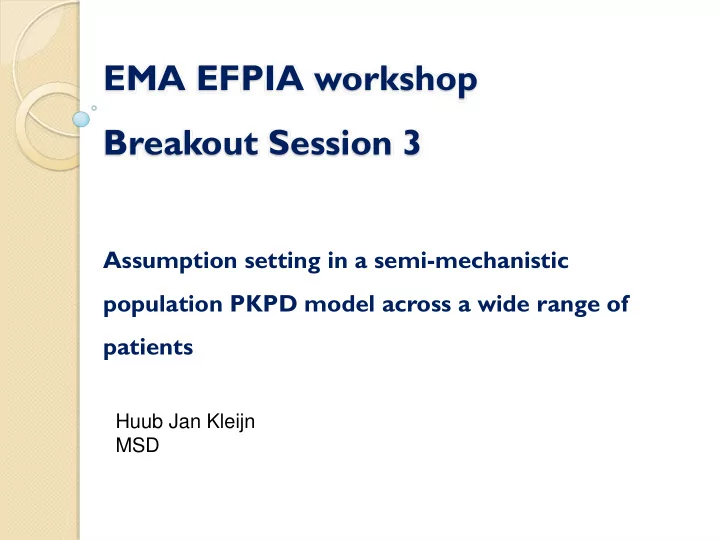

EMA EFPIA workshop Breakout Session 3 Assumption setting in a semi-mechanistic population PKPD model across a wide range of patients Huub Jan Kleijn MSD
Mechanism of Action Rocuronium Sugammadex causes causes fast reversal neuromuscular of neuromuscular block block Rocuronium Placebo (%) 100 50 12:44:39 PM 12:54:39 PM 1:04:39 PM 1:13:54 PM 1:23:09 PM 1:32:24 PM 1:41:39 PM 1:50:54 PM 2:00:09 PM 2:09:24 PM Rocuronium Sugammadex (%) 100 50 8:55:44 AM 9:05:44 AM 9:15:59 AM 9:25:59 AM 9:36:14 AM 9:46:14 AM 9:56:29 AM 10:06:29 AM 10:17:44 AM
Background � Semi-mechanistical population PKPD model to facilitate filing and post-approval process in Europe � Objectives: ◦ Provide ‘evidence’ for dose regimen in pediatric and renal impaired populations ◦ Provide ‘evidence’ on drug interactions � displacement of rocuronium, possible reoccurence of NMB ◦ Be ready for simulating what if questions
Model-based development strategy Historical data supporting assumptions for scaling ADME, physiology yes Will the drug be used in Need to bring in mechanistical components a special population yes / assumptions on complexation ethnic group Heterogeneous patient Rocuronium data supporting assumptions population, is the drug yes on PK and PD model susceptible to interacting drugs ? Can in vitro data be used to support yes extrapolations? Can historical data Shared PD model from other yes population be used? Is the pharmacological yes action similar? Can theoretical PKPD relationships be used to support extrapolations Integrated PKPD model allowing model-based predictions
Data � 9 trials (phase 1 – 3), 446 patients � Age range 1 – 91 yrs ◦ Infant 4 ◦ Child 17 ◦ Adolescent 21 ◦ Adult 247 ◦ Elderly 50 � BW range 9.6 – 139 kg � CLCR range 4.3 – 229 mL/min � Gender 289 males / 157 females � Ethnicity 393 non-asian / 53 asian
PK-PD model assumptions (1) Complexation rocuronium and sugammadex mechanistically described by interaction model using in-vitro determined association constant. (2) Encapsulated rocuronium pharmacokinetically behaves like sugammadex (3) Free rocuronium drives PD. Encapsulated it is pharmacodynamically inactive (4a) Allometric scaling by bodyweight of CL, V (4b) Sugammadex CL driven by renal function (5) PD model structure on literature data (6) Allometric scaling PD rate constants, distribution effects cause PD delay. Enables faster reversal in pediatrics!
Simulations – effects of age and renal clearance on recovery time Median + 90%CI • Size effects translates to recovery time • Effects of other covariates on PK hardly visible on reversal time Effects not clinically relevant, supports the approach of one dose fits all
Simulations – risk of displacement and reoccurrence of NMB − − [ X Sug ] [ Roc Sug ] = = In-vitro assessed K , K A , roc A X K A,roc and K A,x [ X ][ Sug ] [ Roc ][ Sug ] • The in vivo situation is modeled as a single “well-stirred” compartment with rocuronium, sugammadex and third compound X and an effect parameter, the TOF ratio, which depends on the unbound concentration of rocuronium. • Sugammadex and rocuronium are present in this compartment at clinical relevant concentrations. The plasma concentrations are calculated from the population PK interaction model. The third compound is present at a variable concentration. • The unbound fractions of all three compounds are determined by the two association constants (KA) under the assumption of instantaneous equilibrium. • The relationship between TOF ratio and unbound rocuronium concentration as given in the PKPD model
SPC text - Section 4.5 driven by M&S 4.5 Interaction with other medicinal products and other forms of interaction The information in this section is based on binding affinity between sugammadex and other medicinal products, non-clinical experiments, clinical studies and simulations using a model taking into account the pharmacodynamic effect of neuromuscular blocking agents and the pharmacokinetic interaction between neuromuscular blocking agents and sugammadex. Based on these data, no clinically significant pharmacodynamic interaction with other medicinal products is expected, with exception of the following:For toremifene and fusidic acid displacement interactions could not be excluded (no clinically relevant capturing interactions are expected).
Conclusions � Model-based predictions indicated somewhat faster reversal in pediatric population. Simulations supported the approach for one dose fits all � Model-based predictions allowed evaluation of potential drug interaction and identification of possible critical interactions
backup
Calculation CLcr over age range 1 – 91 yrs • For adults and elderly creatinine clearance is calculated according to the formula of Cockcroft – Gault [5]. − × ( 140 age [ yrs ]) bodyweight [ kg ] = CLcr [ mL / min] × 72 serum creatinine [ mg / dL ] For pediatrics (<18 yrs) creatinine will be based upon the formula of • × Schwartz [6]. height [ cm ] k = 2 CLcr [ mL / min/ 1 . 73 m ] serum creatinine [ mg / dL ] k = 0.45 for infants 1 to 52 weeks old k = 0.55 for children 1 to 12 years old k = 0.55 for adolescent females 13 ‐ 18 years old k = 0.7 for adolescent males 13 ‐ 18 years old • BSA normalization in Schwartz derived CLcr was removed • BSA derived from height and weight using Dubois – Dubois equation BSA=W 0.425 x H 0.725 x 71.84
Sugammadex concentrations adequately predicted Allometric scaling
Model predictions in special populations
Recommend
More recommend